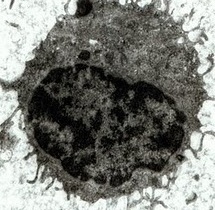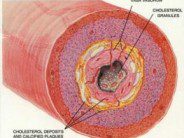 Hairy cell leukemia is a rare hematologic malignancy involving abnormal B lymphocytes that have a characteristically “hairy” appearance under the microscope. The appearance results from cytoplasmic projections that protrude out of the cell. It is sometimes considered a variant or subtype of chronic lymphocytic leukemia and has an annual incidence of less than 2,000 cases in the United States. The disease has an indolent course and is marked by splenomegaly, pancytopenia, and circulating hairy leukemic cells without enlarged lymph nodes. Patients usually don’t receive treatment until they become symptomatic with low blood cell counts resulting in anemia, thrombocytopenia, or neutropenia. Purine analog chemotherapy is the treatment of choice using cladribine or pentostatin monotherapy. Treatment with these drugs usually results in long term remission with 85% of patients achieving a complete response. Most patients can expect a disease free remission of ten years or more. Despite being very well characterized and having an effective treatment, the pathogenetic molecular aberration has not been identified. Researchers lead by Dr. Brunangelo Falini from the University of Perugia in Italy have announced simultaneously online in the New England Journal of Medicine and at the 16th annual meeting of the European Hematology Association that they have identified the BRAF V600E mutation in 100% of hairy cell leukemia cases. Using the powerful approach of genome wide massively parallel sequencing, the researchers analyzed the DNA of leukemic cells and normal blood cells from a patient with hairy cell leukemia. They identified 5 mutations including the BRAF V600E mutation in this index patient. The researchers then analyzed DNA samples from 47 other patients with hairy cell leukemia, and found the mutation in 100% of these patients. Another group of patients with other types of B lymphocyte leukemias and lymphomas were studied but none had the BRAF V600E mutation. Next, the researchers showed that leukemic hairy cells are sensitive to BRAF inhibitors in vitro. In addition, it was shown by immunohistologic and Western blot techniques that both MEK and ERK are phosphorylated in leukemic hairy cells. MEK is the kinase target downstream of BRAF and ERK is the kinase target of MEK. This suggests a constitutive activation of BRAF kinase by the V600E mutation in leukemic hairy cells. Finally, incubating primary leukemic hairy cells with an inhibitor of BRAF V600E led to significantly decreased phosphorylation of both MEK and ERK. We have previously discussed the exciting results obtain using the BRAF V600E inhibitor vemurafenib in metastatic melanoma. Vemurafenib, as well as other BRAF V600E inhibitors, will likely have a role in the targeted treatment of hairy cell leukemia. In addition, the BRAF V600E mutation can now be used in the diagnostic work up of hairy cell leukemia. These are exciting results and add to mankind’s understanding of the molecular etiology of cancer. The authors concluded that “… the BRAF V600E mutant is a potential therapeutic target in patients with [hairy cell leukemia] who do not have a response (or have a suboptimal response) to initial therapy with purine analogues, as well as in patients with repeated relapses or unacceptable toxic effects.”
Hairy cell leukemia is a rare hematologic malignancy involving abnormal B lymphocytes that have a characteristically “hairy” appearance under the microscope. The appearance results from cytoplasmic projections that protrude out of the cell. It is sometimes considered a variant or subtype of chronic lymphocytic leukemia and has an annual incidence of less than 2,000 cases in the United States. The disease has an indolent course and is marked by splenomegaly, pancytopenia, and circulating hairy leukemic cells without enlarged lymph nodes. Patients usually don’t receive treatment until they become symptomatic with low blood cell counts resulting in anemia, thrombocytopenia, or neutropenia. Purine analog chemotherapy is the treatment of choice using cladribine or pentostatin monotherapy. Treatment with these drugs usually results in long term remission with 85% of patients achieving a complete response. Most patients can expect a disease free remission of ten years or more. Despite being very well characterized and having an effective treatment, the pathogenetic molecular aberration has not been identified. Researchers lead by Dr. Brunangelo Falini from the University of Perugia in Italy have announced simultaneously online in the New England Journal of Medicine and at the 16th annual meeting of the European Hematology Association that they have identified the BRAF V600E mutation in 100% of hairy cell leukemia cases. Using the powerful approach of genome wide massively parallel sequencing, the researchers analyzed the DNA of leukemic cells and normal blood cells from a patient with hairy cell leukemia. They identified 5 mutations including the BRAF V600E mutation in this index patient. The researchers then analyzed DNA samples from 47 other patients with hairy cell leukemia, and found the mutation in 100% of these patients. Another group of patients with other types of B lymphocyte leukemias and lymphomas were studied but none had the BRAF V600E mutation. Next, the researchers showed that leukemic hairy cells are sensitive to BRAF inhibitors in vitro. In addition, it was shown by immunohistologic and Western blot techniques that both MEK and ERK are phosphorylated in leukemic hairy cells. MEK is the kinase target downstream of BRAF and ERK is the kinase target of MEK. This suggests a constitutive activation of BRAF kinase by the V600E mutation in leukemic hairy cells. Finally, incubating primary leukemic hairy cells with an inhibitor of BRAF V600E led to significantly decreased phosphorylation of both MEK and ERK. We have previously discussed the exciting results obtain using the BRAF V600E inhibitor vemurafenib in metastatic melanoma. Vemurafenib, as well as other BRAF V600E inhibitors, will likely have a role in the targeted treatment of hairy cell leukemia. In addition, the BRAF V600E mutation can now be used in the diagnostic work up of hairy cell leukemia. These are exciting results and add to mankind’s understanding of the molecular etiology of cancer. The authors concluded that “… the BRAF V600E mutant is a potential therapeutic target in patients with [hairy cell leukemia] who do not have a response (or have a suboptimal response) to initial therapy with purine analogues, as well as in patients with repeated relapses or unacceptable toxic effects.”
Reference:
Tiacci E, et al. “BRAF mutations in hairy-cell leukemia” N Engl J Med 2011; DOI: 10.1056/NEJMoa1014209.










 DrSamGirgis.com is a blog about medicine, nutrition, health, wellness, and breaking medical news. At DrSamGirgis.com, the goal is to provide a forum for discussion on health and wellness topics and to provide the latest medical research findings and breaking medical news commentary.
DrSamGirgis.com is a blog about medicine, nutrition, health, wellness, and breaking medical news. At DrSamGirgis.com, the goal is to provide a forum for discussion on health and wellness topics and to provide the latest medical research findings and breaking medical news commentary.
{ 0 comments… add one now }